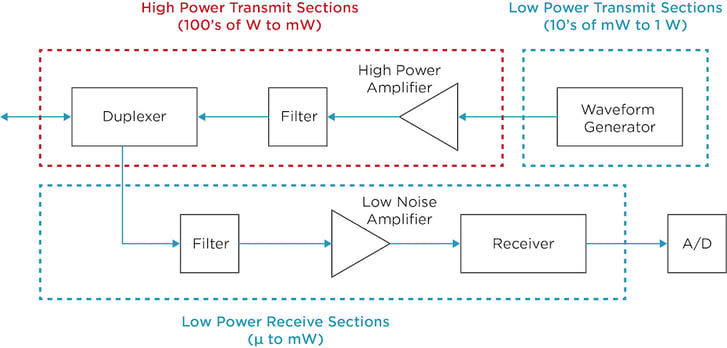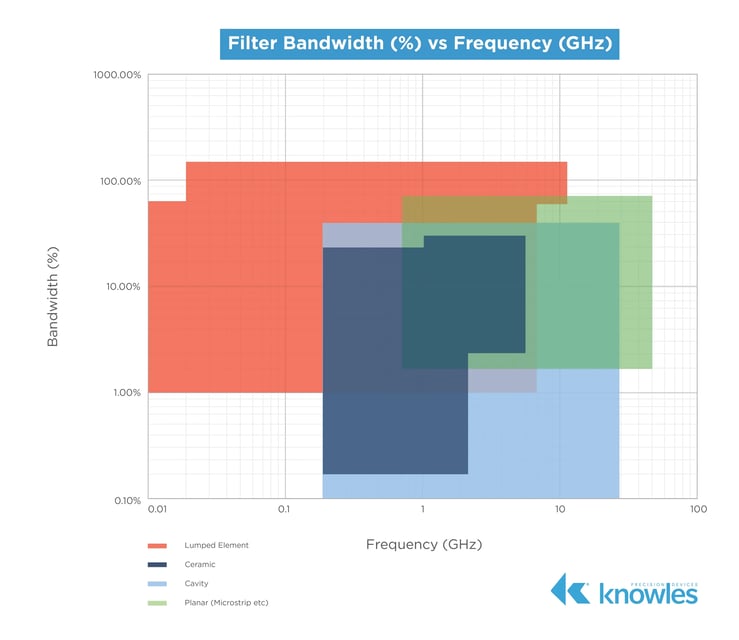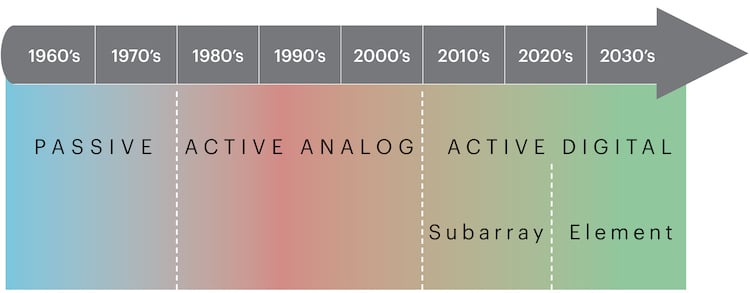RF Components for Radar: Overview and Trends
Starvoy Technolgies represents Knowles Precision Devices across Canada – the below recently appeared on Knowles’ blog. For further information on the below – reach out to your account manager, or [email protected]
Radar systems are designed to detect and identify an object’s location. They use short bursts of energy to transmit radio frequency (RF) and microwave signals and gather information from the echoed signal returned by the object.
Here, we’ll introduce radar, including its key functional units and technological evolution.
Key Functional Components in Radar Systems
We can learn a lot about radar systems by looking at the functional components and what specific tasks they perform. In the diagram below, we treat each function as a separate block, even though these functions can be combined or divided across several circuits.

Key functions in radar systems include:
Duplexing
A duplexer is tasked with ensuring that transmit and receive signals avoid collisions. T/R waveguide tube devices, circulators, filters and switches can all perform this task in different configurations. For example, in low-power T/R modules, a switch might be the preferred duplexer because they’re small and easy to integrate.
Filtering
Radar systems can leverage filters on both the transmit and receive paths depending on the frequency of operation and bandwidth requirements of the system. Filters also play a key role in protecting data converters in direct sampling systems.

Power Amplification
High-power amplifiers take signals from the waveform generator and increase their signal level to a higher power. Depending on the system, the increase could take the signal from hundreds of watts to megawatts. For example, PAVE PAWS was an early warning radar system and the first all-solid-state active electronically steered array (AESA) system. It had a transmit power of 340W per T/R module. Summed over 1,792 modules, the signal ended up at over 500 kW. High-power amplifiers usually leverage bypass capacitors, pulse storage capacitors and couplers.
Waveform Generation
Waveform generators create transmit fairly low-power waveforms. These waveforms are pulsed or otherwise and modulated in frequency or phase as needed. Modern waveform generators are based on digital waveform generation (DWG) and are functionally similar to the arbitrary waveform generators (AWG) commonly found in an RF lab. Here, the desired waveform is expressed mathematically. Through direct digital synthesis (DDS), a digital-to-analog converter (DAC) can produce an analog signal from a digital input. In frequency synthesis, a low-phase noise oscillator with a small form factor is key.
Low Noise Amplification
Low-noise amplifiers (LNAs) amplify low-amplitude waveforms without decreasing their signal-to-noise ratio (SNR). A strong SNR improves the chances of detecting a target, so LNAs make it possible to detect these hard-to-find targets. Effectiveness is a measure of both resolution and accuracy. Accuracy improves as SNR increases. LNAs rely on bypass capacitors, bias networks, and gain equalizers.
Receiving
Receivers are tasked with preparing input frequencies for the analog-to-digital converter (ADC). Depending on the frequencies and sensitivity requirements, one or more down conversion stages may be required. Each stage requires filtering, amplification, and frequency conversion with the help of a low-phase noise frequency source.
Analog to Digital Conversion
The goal is to get the signal from the antenna into the analog-to-digital converter (ADC) as directly as possible by removing RF components in its path. When the ADC input matches the RF frequency seen at the antenna, RF sampling and direct sampling become relevant. An RF-ADC’s sampling rate, analog bandwidth, resolution and dynamic range help determine its ability to be used in RF sampling.
Phased Array Evolution
Radar plays a critical role in defense communications, law enforcement, space exploration, remote sensing and air traffic control. To accommodate different applications, these systems operate in a variety of frequency bands, including L, S, C, X and K bands. With high demand for multi-function, multi-mission systems, options like synthetic-aperture radar (SAR), featuring additional capabilities for imaging and tracking are becoming more popular too.
The most recent transition, shifting the industry from subarray digital phased arrays to element-level digital arrays, demonstrates some key benefits. We’re seeing more flexibility of mode and bandwidth, and when each element in the array has its own ADC, there’s an inherent increase in SNR.

The Expansion of Digital Architecture
With advancements in adjacent areas like RF and digital electronics, digital arrays are applicable in a wider variety of systems. Considering that these technologies build on each other, a digital-array radar is built on the fundamentals of a phased array antenna; however, in fully digital arrays, transmitted and received energy can be digitized at the element level. Digital-array radar can form multiple receive beams simultaneously. The number of beams, instantaneous bandwidth and dynamic range are only limited by the data converters, digital hardware specifications and power consumption.
As the industry expands on the capabilities of RF-ADCs in terms of analog bandwidth and sampling frequency, every-element DREX circuits are starting to emerge. This places fast converters close to the antenna and encourages the development of high-rejection filters to protect receivers.
Knowles Precision Devices in Radar
Knowles Precision Devices is a trusted problem solver with decades of experience serving the defense and aerospace industries. Our RF components and capacitors are designed with size, weight and power (SWAP) in mind, and we use vertical integration to provide high-performance components for your unique circuit challenge.
This marks the start of our “RF Components for Radar” series. From here, we’ll take a closer look at the RF components behind each of the functional units we’ve mentioned here. In the meantime, read Expanding Our Filter Technology Offerings to Serve Low-Frequency Applications for more information on our catalog.

